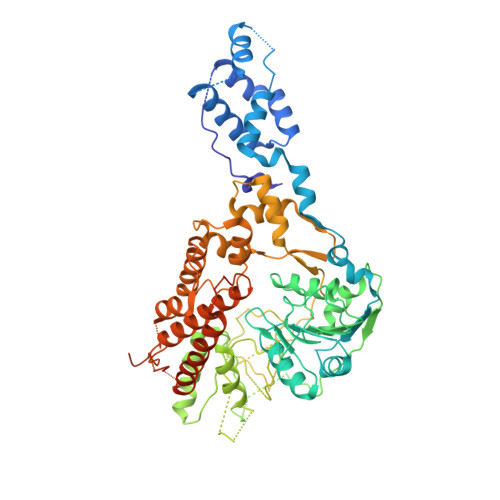Dimeric assembly of human Suv3 helicase promotes its RNA unwinding function in mitochondrial RNA degradosome for RNA decay.
Jain, M., Golzarroshan, B., Lin, C.L., Agrawal, S., Tang, W.H., Wu, C.J., Yuan, H.S.(2022) Protein Sci 31: e4312-e4312
- PubMed: 35481630
- DOI: https://doi.org/10.1002/pro.4312
- Primary Citation of Related Structures:
7W1R - PubMed Abstract:
Human Suv3 is a unique homodimeric helicase that constitutes the major component of the mitochondrial degradosome to work cooperatively with exoribonuclease PNPase for efficient RNA decay. However, the molecular mechanism of how Suv3 is assembled into a homodimer to unwind RNA remains elusive. Here, we show that dimeric Suv3 preferentially binds to and unwinds DNA-DNA, DNA-RNA, and RNA-RNA duplexes with a long 3' overhang (≥10 nucleotides). The C-terminal tail (CTT)-truncated Suv3 (Suv3ΔC) becomes a monomeric protein that binds to and unwinds duplex substrates with ~six to sevenfold lower activities relative to dimeric Suv3. Only dimeric Suv3, but not monomeric Suv3ΔC, binds RNA independently of ATP or ADP, and is capable of interacting with PNPase, indicating that dimeric Suv3 assembly ensures its continuous association with RNA and PNPase during ATP hydrolysis cycles for efficient RNA degradation. We further determined the crystal structure of the apo-form of Suv3ΔC, and SAXS structures of dimeric Suv3 and PNPase-Suv3 complex, showing that dimeric Suv3 caps on the top of PNPase via interactions with S1 domains, and forms a dumbbell-shaped degradosome complex with PNPase. Overall, this study reveals that Suv3 is assembled into a dimeric helicase by its CTT for efficient and persistent RNA binding and unwinding to facilitate interactions with PNPase, promote RNA degradation, and maintain mitochondrial genome integrity and homeostasis.
Organizational Affiliation:
Molecular and Cell Biology, Taiwan International Graduate Program, Academia Sinica and Graduate Institute of Life Sciences, National Defense Medical Center, Taipei, Taiwan.














